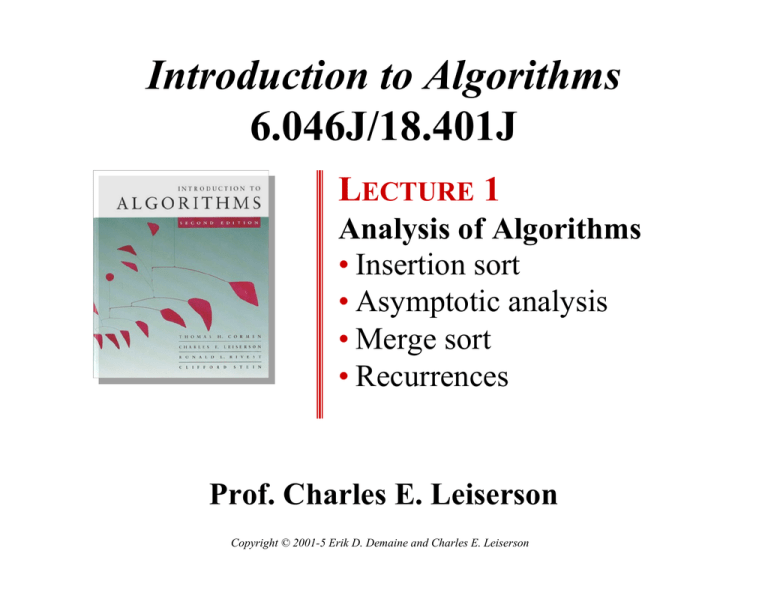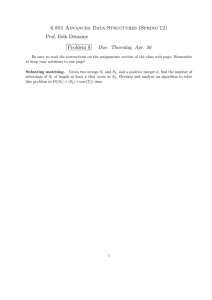Introduction to Algorithms 6.046J/18.401J L 1
advertisement

Introduction to Algorithms
6.046J/18.401J
LECTURE 1
Analysis of Algorithms
• Insertion sort
• Asymptotic analysis
• Merge sort
• Recurrences
Prof. Charles E. Leiserson
Copyright © 2001-5 Erik D. Demaine and Charles E. Leiserson
Course information
1.
2.
3.
4.
5.
6.
7.
Staff
Distance learning
Prerequisites
Lectures
Recitations
Handouts
Textbook
September 7, 2005
8.
9.
10.
11.
12.
13.
14.
Course website
Extra help
Registration
Problem sets
Describing algorithms
Grading policy
Collaboration policy
Introduction to Algorithms
L1.2
Analysis of algorithms
The theoretical study of computer-program
performance and resource usage.
What’s more important than performance?
• modularity
• user-friendliness
• correctness
• programmer time
• maintainability
• simplicity
• functionality
• extensibility
• robustness
• reliability
September 7, 2005
Copyright © 2001-5 Erik D. Demaine and Charles E. Leiserson
Introduction to Algorithms
L1.3
Why study algorithms and
performance?
• Algorithms help us to understand scalability.
• Performance often draws the line between what
is feasible and what is impossible.
• Algorithmic mathematics provides a language
for talking about program behavior.
• Performance is the currency of computing.
• The lessons of program performance generalize
to other computing resources.
• Speed is fun!
September 7, 2005
Copyright © 2001-5 Erik D. Demaine and Charles E. Leiserson
Introduction to Algorithms
L1.4
The problem of sorting
Input: sequence ⟨a1, a2, …, an⟩ of numbers.
Output: permutation ⟨a'1, a'2, …, a'n⟩ such
that a'1 ≤ a'2 ≤ … ≤ a'n .
Example:
Input: 8 2 4 9 3 6
Output: 2 3 4 6 8 9
September 7, 2005
Copyright © 2001-5 Erik D. Demaine and Charles E. Leiserson
Introduction to Algorithms
L1.5
Insertion sort
“pseudocode”
September 7, 2005
INSERTION-SORT (A, n)
⊳ A[1 . . n]
for j ← 2 to n
do key ← A[ j]
i←j–1
while i > 0 and A[i] > key
do A[i+1] ← A[i]
i←i–1
A[i+1] = key
Copyright © 2001-5 Erik D. Demaine and Charles E. Leiserson
Introduction to Algorithms
L1.6
Insertion sort
INSERTION-SORT (A, n)
⊳ A[1 . . n]
for j ← 2 to n
do key ← A[ j]
i←j–1
while i > 0 and A[i] > key
do A[i+1] ← A[i]
i←i–1
A[i+1] = key
“pseudocode”
1
i
j
n
A:
sorted
September 7, 2005
key
Copyright © 2001-5 Erik D. Demaine and Charles E. Leiserson
Introduction to Algorithms
L1.7
Example of insertion sort
8
September 7, 2005
2
4
9
3
Copyright © 2001-5 Erik D. Demaine and Charles E. Leiserson
Introduction to Algorithms
6
L1.8
Example of insertion sort
8
September 7, 2005
2
4
9
3
Copyright © 2001-5 Erik D. Demaine and Charles E. Leiserson
Introduction to Algorithms
6
L1.9
Example of insertion sort
September 7, 2005
8
2
4
9
3
6
2
8
4
9
3
6
Copyright © 2001-5 Erik D. Demaine and Charles E. Leiserson
Introduction to Algorithms
L1.10
Example of insertion sort
September 7, 2005
8
2
4
9
3
6
2
8
4
9
3
6
Copyright © 2001-5 Erik D. Demaine and Charles E. Leiserson
Introduction to Algorithms
L1.11
Example of insertion sort
September 7, 2005
8
2
4
9
3
6
2
8
4
9
3
6
2
4
8
9
3
6
Copyright © 2001-5 Erik D. Demaine and Charles E. Leiserson
Introduction to Algorithms
L1.12
Example of insertion sort
September 7, 2005
8
2
4
9
3
6
2
8
4
9
3
6
2
4
8
9
3
6
Copyright © 2001-5 Erik D. Demaine and Charles E. Leiserson
Introduction to Algorithms
L1.13
Example of insertion sort
September 7, 2005
8
2
4
9
3
6
2
8
4
9
3
6
2
4
8
9
3
6
2
4
8
9
3
6
Copyright © 2001-5 Erik D. Demaine and Charles E. Leiserson
Introduction to Algorithms
L1.14
Example of insertion sort
September 7, 2005
8
2
4
9
3
6
2
8
4
9
3
6
2
4
8
9
3
6
2
4
8
9
3
6
Copyright © 2001-5 Erik D. Demaine and Charles E. Leiserson
Introduction to Algorithms
L1.15
Example of insertion sort
September 7, 2005
8
2
4
9
3
6
2
8
4
9
3
6
2
4
8
9
3
6
2
4
8
9
3
6
2
3
4
8
9
6
Copyright © 2001-5 Erik D. Demaine and Charles E. Leiserson
Introduction to Algorithms
L1.16
Example of insertion sort
September 7, 2005
8
2
4
9
3
6
2
8
4
9
3
6
2
4
8
9
3
6
2
4
8
9
3
6
2
3
4
8
9
6
Copyright © 2001-5 Erik D. Demaine and Charles E. Leiserson
Introduction to Algorithms
L1.17
Example of insertion sort
September 7, 2005
8
2
4
9
3
6
2
8
4
9
3
6
2
4
8
9
3
6
2
4
8
9
3
6
2
3
4
8
9
6
2
3
4
6
8
9 done
Copyright © 2001-5 Erik D. Demaine and Charles E. Leiserson
Introduction to Algorithms
L1.18
Running time
• The running time depends on the input: an
already sorted sequence is easier to sort.
• Parameterize the running time by the size of
the input, since short sequences are easier to
sort than long ones.
• Generally, we seek upper bounds on the
running time, because everybody likes a
guarantee.
September 7, 2005
Copyright © 2001-5 Erik D. Demaine and Charles E. Leiserson
Introduction to Algorithms
L1.19
Kinds of analyses
Worst-case: (usually)
• T(n) = maximum time of algorithm
on any input of size n.
Average-case: (sometimes)
• T(n) = expected time of algorithm
over all inputs of size n.
• Need assumption of statistical
distribution of inputs.
Best-case: (bogus)
• Cheat with a slow algorithm that
works fast on some input.
September 7, 2005
Copyright © 2001-5 Erik D. Demaine and Charles E. Leiserson
Introduction to Algorithms
L1.20
Machine-independent time
What is insertion sort’s worst-case time?
• It depends on the speed of our computer:
• relative speed (on the same machine),
• absolute speed (on different machines).
BIG IDEA:
• Ignore machine-dependent constants.
• Look at growth of T(n) as n → ∞ .
“Asymptotic Analysis”
September 7, 2005
Copyright © 2001-5 Erik D. Demaine and Charles E. Leiserson
Introduction to Algorithms
L1.21
Θ-notation
Math:
Θ(g(n)) = { f (n) : there exist positive constants c1, c2, and
n0 such that 0 ≤ c1 g(n) ≤ f (n) ≤ c2 g(n)
for all n ≥ n0 }
Engineering:
• Drop low-order terms; ignore leading constants.
• Example: 3n3 + 90n2 – 5n + 6046 = Θ(n3)
September 7, 2005
Copyright © 2001-5 Erik D. Demaine and Charles E. Leiserson
Introduction to Algorithms
L1.22
Asymptotic performance
When n gets large enough, a Θ(n2) algorithm
always beats a Θ(n3) algorithm.
T(n)
n
September 7, 2005
n0
• We shouldn’t ignore
asymptotically slower
algorithms, however.
• Real-world design
situations often call for a
careful balancing of
engineering objectives.
• Asymptotic analysis is a
useful tool to help to
structure our thinking.
Copyright © 2001-5 Erik D. Demaine and Charles E. Leiserson
Introduction to Algorithms
L1.23
Insertion sort analysis
Worst case: Input reverse sorted.
T ( n) =
n
2)
(
Θ
(
j
)
=
Θ
n
∑
[arithmetic series]
j =2
Average case: All permutations equally likely.
T ( n) =
n
∑ Θ( j / 2) = Θ(n 2 )
j =2
Is insertion sort a fast sorting algorithm?
• Moderately so, for small n.
• Not at all, for large n.
September 7, 2005
Copyright © 2001-5 Erik D. Demaine and Charles E. Leiserson
Introduction to Algorithms
L1.24
Merge sort
MERGE-SORT A[1 . . n]
1. If n = 1, done.
2. Recursively sort A[ 1 . . ⎡n/2⎤ ]
and A[ ⎡n/2⎤+1 . . n ] .
3. “Merge” the 2 sorted lists.
Key subroutine: MERGE
September 7, 2005
Copyright © 2001-5 Erik D. Demaine and Charles E. Leiserson
Introduction to Algorithms
L1.25
Merging two sorted arrays
20 12
13 11
7
9
2
1
September 7, 2005
Copyright © 2001-5 Erik D. Demaine and Charles E. Leiserson
Introduction to Algorithms
L1.26
Merging two sorted arrays
20 12
13 11
7
9
2
1
1
September 7, 2005
Copyright © 2001-5 Erik D. Demaine and Charles E. Leiserson
Introduction to Algorithms
L1.27
Merging two sorted arrays
20 12
20 12
13 11
13 11
7
9
7
2
1
2
9
1
September 7, 2005
Copyright © 2001-5 Erik D. Demaine and Charles E. Leiserson
Introduction to Algorithms
L1.28
Merging two sorted arrays
20 12
20 12
13 11
13 11
7
9
7
2
1
2
1
September 7, 2005
9
2
Copyright © 2001-5 Erik D. Demaine and Charles E. Leiserson
Introduction to Algorithms
L1.29
Merging two sorted arrays
20 12
20 12
20 12
13 11
13 11
13 11
7
9
7
2
1
2
1
September 7, 2005
9
7
9
2
Copyright © 2001-5 Erik D. Demaine and Charles E. Leiserson
Introduction to Algorithms
L1.30
Merging two sorted arrays
20 12
20 12
20 12
13 11
13 11
13 11
7
9
7
2
1
2
1
September 7, 2005
9
2
7
9
7
Copyright © 2001-5 Erik D. Demaine and Charles E. Leiserson
Introduction to Algorithms
L1.31
Merging two sorted arrays
20 12
20 12
20 12
20 12
13 11
13 11
13 11
13 11
7
9
7
2
1
2
1
September 7, 2005
9
2
7
9
9
7
Copyright © 2001-5 Erik D. Demaine and Charles E. Leiserson
Introduction to Algorithms
L1.32
Merging two sorted arrays
20 12
20 12
20 12
20 12
13 11
13 11
13 11
13 11
7
9
7
2
1
2
1
September 7, 2005
9
2
7
9
7
9
9
Copyright © 2001-5 Erik D. Demaine and Charles E. Leiserson
Introduction to Algorithms
L1.33
Merging two sorted arrays
20 12
20 12
20 12
20 12
20 12
13 11
13 11
13 11
13 11
13 11
7
9
7
2
1
2
1
September 7, 2005
9
2
7
9
7
9
9
Copyright © 2001-5 Erik D. Demaine and Charles E. Leiserson
Introduction to Algorithms
L1.34
Merging two sorted arrays
20 12
20 12
20 12
20 12
20 12
13 11
13 11
13 11
13 11
13 11
7
9
7
2
1
2
1
September 7, 2005
9
2
7
9
7
9
9
Copyright © 2001-5 Erik D. Demaine and Charles E. Leiserson
Introduction to Algorithms
11
L1.35
Merging two sorted arrays
20 12
20 12
20 12
20 12
20 12
20 12
13 11
13 11
13 11
13 11
13 11
13
7
9
7
2
1
2
1
September 7, 2005
9
2
7
9
7
9
9
Copyright © 2001-5 Erik D. Demaine and Charles E. Leiserson
Introduction to Algorithms
11
L1.36
Merging two sorted arrays
20 12
20 12
20 12
20 12
20 12
20 12
13 11
13 11
13 11
13 11
13 11
13
7
9
7
2
1
2
1
September 7, 2005
9
2
7
9
7
9
9
Copyright © 2001-5 Erik D. Demaine and Charles E. Leiserson
Introduction to Algorithms
11
12
L1.37
Merging two sorted arrays
20 12
20 12
20 12
20 12
20 12
20 12
13 11
13 11
13 11
13 11
13 11
13
7
9
7
2
1
2
1
9
2
7
9
7
9
9
11
12
Time = Θ(n) to merge a total
of n elements (linear time).
September 7, 2005
Copyright © 2001-5 Erik D. Demaine and Charles E. Leiserson
Introduction to Algorithms
L1.38
Analyzing merge sort
T(n)
MERGE-SORT A[1 . . n]
Θ(1)
1. If n = 1, done.
2T(n/2) 2. Recursively sort A[ 1 . . ⎡n/2⎤ ]
Abuse
and A[ ⎡n/2⎤+1 . . n ] .
Θ(n)
3. “Merge” the 2 sorted lists
Sloppiness: Should be T( ⎡n/2⎤ ) + T( ⎣n/2⎦ ) ,
but it turns out not to matter asymptotically.
September 7, 2005
Copyright © 2001-5 Erik D. Demaine and Charles E. Leiserson
Introduction to Algorithms
L1.39
Recurrence for merge sort
T(n) =
Θ(1) if n = 1;
2T(n/2) + Θ(n) if n > 1.
• We shall usually omit stating the base
case when T(n) = Θ(1) for sufficiently
small n, but only when it has no effect on
the asymptotic solution to the recurrence.
• CLRS and Lecture 2 provide several ways
to find a good upper bound on T(n).
September 7, 2005
Copyright © 2001-5 Erik D. Demaine and Charles E. Leiserson
Introduction to Algorithms
L1.40
Recursion tree
Solve T(n) = 2T(n/2) + cn, where c > 0 is constant.
September 7, 2005
Copyright © 2001-5 Erik D. Demaine and Charles E. Leiserson
Introduction to Algorithms
L1.41
Recursion tree
Solve T(n) = 2T(n/2) + cn, where c > 0 is constant.
T(n)
September 7, 2005
Copyright © 2001-5 Erik D. Demaine and Charles E. Leiserson
Introduction to Algorithms
L1.42
Recursion tree
Solve T(n) = 2T(n/2) + cn, where c > 0 is constant.
cn
T(n/2)
T(n/2)
September 7, 2005
Copyright © 2001-5 Erik D. Demaine and Charles E. Leiserson
Introduction to Algorithms
L1.43
Recursion tree
Solve T(n) = 2T(n/2) + cn, where c > 0 is constant.
cn
cn/2
cn/2
T(n/4)
September 7, 2005
T(n/4)
T(n/4)
T(n/4)
Copyright © 2001-5 Erik D. Demaine and Charles E. Leiserson
Introduction to Algorithms
L1.44
Recursion tree
Solve T(n) = 2T(n/2) + cn, where c > 0 is constant.
cn
cn/2
cn/2
cn/4
cn/4
cn/4
…
cn/4
Θ(1)
September 7, 2005
Copyright © 2001-5 Erik D. Demaine and Charles E. Leiserson
Introduction to Algorithms
L1.45
Recursion tree
Solve T(n) = 2T(n/2) + cn, where c > 0 is constant.
cn
cn/2
cn/2
cn/4
cn/4
cn/4
…
h = lg n cn/4
Θ(1)
September 7, 2005
Copyright © 2001-5 Erik D. Demaine and Charles E. Leiserson
Introduction to Algorithms
L1.46
Recursion tree
Solve T(n) = 2T(n/2) + cn, where c > 0 is constant.
cn
cn
cn/2
cn/2
cn/4
cn/4
cn/4
…
h = lg n cn/4
Θ(1)
September 7, 2005
Copyright © 2001-5 Erik D. Demaine and Charles E. Leiserson
Introduction to Algorithms
L1.47
Recursion tree
Solve T(n) = 2T(n/2) + cn, where c > 0 is constant.
cn
cn
cn/2
cn/2
cn/4
cn/4
cn/4
…
h = lg n cn/4
cn
Θ(1)
September 7, 2005
Copyright © 2001-5 Erik D. Demaine and Charles E. Leiserson
Introduction to Algorithms
L1.48
Recursion tree
Solve T(n) = 2T(n/2) + cn, where c > 0 is constant.
cn
cn
cn/2
cn/2
cn/4
cn/4
cn/4
cn
…
…
h = lg n cn/4
cn
Θ(1)
September 7, 2005
Copyright © 2001-5 Erik D. Demaine and Charles E. Leiserson
Introduction to Algorithms
L1.49
Recursion tree
Solve T(n) = 2T(n/2) + cn, where c > 0 is constant.
cn
cn
cn/2
cn/2
cn/4
cn/4
Θ(1)
September 7, 2005
cn/4
cn
…
…
h = lg n cn/4
cn
#leaves = n
Copyright © 2001-5 Erik D. Demaine and Charles E. Leiserson
Introduction to Algorithms
Θ(n)
L1.50
Recursion tree
Solve T(n) = 2T(n/2) + cn, where c > 0 is constant.
cn
cn
cn/2
cn/2
cn/4
cn/4
cn/4
Θ(1)
cn
…
…
h = lg n cn/4
cn
Θ(n)
#leaves = n
Total = Θ(n lg n)
September 7, 2005
Copyright © 2001-5 Erik D. Demaine and Charles E. Leiserson
Introduction to Algorithms
L1.51
Conclusions
• Θ(n lg n) grows more slowly than Θ(n2).
• Therefore, merge sort asymptotically
beats insertion sort in the worst case.
• In practice, merge sort beats insertion
sort for n > 30 or so.
• Go test it out for yourself!
September 7, 2005
Copyright © 2001-5 Erik D. Demaine and Charles E. Leiserson
Introduction to Algorithms
L1.52






